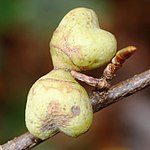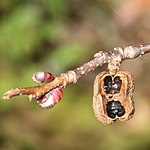Disanthus cercidifolius

| Disanthus cercidifolius | |
|---|---|
 | |
| D. cercidifolia (sic), Curtis's Botanical Magazine, 1917 | |
| Scientific classification | |
| Kingdom: | Plantae |
| Clade: | Tracheophytes |
| Clade: | Angiosperms |
| Clade: | Eudicots |
| Order: | Saxifragales |
| Family: | Hamamelidaceae |
| Genus: | Disanthus |
| Species: | D. cercidifolius |
| Binomial name | |
| Disanthus cercidifolius | |
Disanthus cercidifolius is a species of flowering plant in the family Hamamelidaceae. It is native to woodland habitats in China and Japan.[1]
Nomenclature
[edit]The term Disanthus refers to the flowers that come in axillary pairs. The Latin specific epithet cercidifolius means "with leaves like the redbud tree (Cercis)".[2] The epithet was originally spelled D. cercidifolia.[3] The International Code of Nomenclature for algae, fungi, and plants stipulates that the Latin grammatical gender is masculine, and so the spelling is D. cercidifolius.[4]
Description
[edit]Disanthus cercidifolius is a medium-sized deciduous shrub growing to 3 m (10 ft) tall and wide. It is noted for its heart-shaped leaves which turn to shades of red, purple and yellow in autumn.[5][6]
- 2 flowers
- 2 fruits
- fruit without seeds
- leaf
- Varieties
- Disanthus cercidifolius var. longipes — endemic to China.
Cultivation
[edit]Disanthus cercidifolius is cultivated as an ornamental plant. It is a calcifuge, requiring a lime-free soil.
The plant has gained the Royal Horticultural Society's Award of Garden Merit.[7]
'Ena Nishiki' is a variegated cultivar with white and green foliage while 'Golden Crown' is a white and yellow variegated cultivar.
References
[edit]- ^ Zhi-Yun Zhang; Hongda Zhang; Peter K. Endress, "Disanthus Maximowicz, Bull. Acad. Imp. Sci. Saint-Pétersbourg. 10: 485. 1866", Flora of China
- ^ Harrison, Lorraine (2012). RHS Latin for Gardeners. United Kingdom: Mitchell Beazley. ISBN 978-1845337315.
- ^ Maximowicz, C. J. (1866), "Diagnoses breves plantarum novarum Japoniae et Mandshuriae/Courtes diagnoses des nouvelles plantes provenant du Japon et de la Mandchourie", Bulletin de l'Académie impériale des sciences de St.-Pétersbourg, series 3, volume 10: 485–490
- ^ McNeill, J.; Barrie, F.R.; Buck, W.R.; Demoulin, V.; Greuter, W.; Hawksworth, D.L.; Herendeen, P.S.; Knapp, S.; Marhold, K.; Prado, J.; Prud'homme Van Reine, W.F.; Smith, G.F.; Wiersema, J.H.; Turland, N.J. (2012), International Code of Nomenclature for algae, fungi, and plants (Melbourne Code) adopted by the Eighteenth International Botanical Congress Melbourne, Australia, July 2011, vol. Regnum Vegetabile 154, A.R.G. Gantner Verlag KG, ISBN 978-3-87429-425-6 Article 62.2(c)
- ^ RHS A-Z encyclopedia of garden plants. United Kingdom: Dorling Kindersley. 2008. p. 1136. ISBN 978-1405332965.
- ^ "Missouri Botanical Garden - Disanthus cercidifolius". Retrieved 18 June 2013.
- ^ "RHS Plant Selector - Disanthus cercidifolius". Retrieved 27 May 2020.



